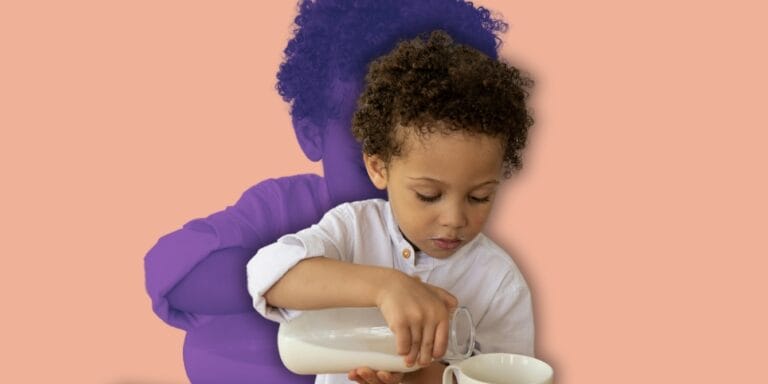8 ways to prevent lice from coming home with your child from school or day care

When the dreaded "lice alert" flyer comes home in your child's backpack, here's what to do.
We independently select and share the products we love—and may receive a commission if you choose to buy.
Table of Contents
Every parent dreads getting the “lice alert” flyer in their child’s backpack. But much like colds, stomach bugs, and putting on shoes at the speed of molasses unfortunately, head lice is a common affliction of childhood. Outbreaks happen even in the cleanest, most spic-and-span classrooms to any child with any type of hair.
It’s never too early to start teaching your preschooler or grade schooler some basic lice prevention tricks. Most kids are eager to get on board the lice prevention train, especially after first-hand experience with the itchy buggers. And the good news is that some of the most effective ways to prevent lice are simple enough for kids to grasp easily.
Here are tips on how to prevent lice from coming home with your child from school or day care—plus how to tell if your child has lice.
1. When it comes to lice prevention, not sharing is best.
Teach children not to share combs, brushes, hats, bike helmets or hair ties. Doing this will get kids in the habit of not sharing hair tools that make it easy for lice to spread. If a lice outbreak does happen, keep hats, coats, combs and other personal items separate to prevent lice from spreading.
2. Style your child’s hair up and out of the way.
Keep long hair in a ponytail, or better yet, a braid. This helps make the hair harder for lice to attach to. For shorter hair, try styling the hair up and away from the ears and nape with gel or spray.
3. Use a lice repellent spray daily.
Repellent sprays containing tea tree, citronella, lavender and geranium oils may help prevent the spread of head lice. Spray your child’s hair each morning, liberally applying to lice “hot spots,” such as the back of the neck, behind the ears and along part lines. Spray can be used on coats, backpacks and hats as well.
4. Lice comb after the bath at least once a week
Catching live lice before they have a chance to lay eggs is the key to avoiding a full on outbreak. By running a lice comb through their hair once or twice a week you’ll catch those clever buggers before they can multiply and truly wreak havoc.
5. Keep children’s coats separated.
As seasoned teachers and day care providers know, when lice appear in the classroom, it’s time to make sure children’s coats and jackets are stored separately to help prevent the spread of lice. Why? Lice don’t fly or jump, they walk—and they can easily walk from one child’s coat to another when coats are hung together in a closet. If your child’s classroom or day care doesn’t have a separate cubby for each child, bring a plastic bag or garment bag to store your child’s coat in during the day.
6. Clean frequently-used items.
To prevent the spread of lice, thoroughly clean items that children tend to share on a regular basis, like blankets, stuffed animals, headphones, and dress-up costumes.
7. Keep nap mats sealed & separated.
If your child’s day care or preschool uses mats or pillows at nap time, work with your child’s teacher to help make sure that nap mats are kept separated in large, sealed bags when not in use.
8. Soak hair care items.
Soak brushes, combs, hair ties and other hair care products in a warm solution of water and medicated lice shampoo at least once a week.
How can you tell if your child has lice?
An itchy scalp is the hallmark symptom of a case of head lice. However, the itching may not always start immediately and may sometimes be delayed for weeks as a case of head lice develops.
If you suspect your child may have been exposed, check for lice and nits using a fine-tooth comb on the scalp, behind the ears and around the nape of the neck. A magnifying glass and bright light may help as well. Since nits can take 10 days to hatch, you do need to recheck your child’s hair nightly using a good lice comb, such as the Nit Free Terminator Comb. Natural products such as yeast enzymes, salt and water can dissolve the body of the bug and help remove the stubborn nit glue.
Follow these steps when checking for lice:
- Seat your child in a brightly-lit room and use a flashlight or head lamp to get a better look.
- Part hair and examine the scalp one section at a time. Look for crawling lice and nits on your child’s scalp, especially behind the ears or at the nape of the neck where they most like to camp out.
- Note that live lice are hard to find—they avoid light and move quickly.
- Nits will look like small white or yellow-brown specks, firmly attached to the hair near the scalp. The easiest place to find them is at the hairline at the back of the neck or behind the ears. Nits can be confused with many other things such as dandruff, dirt particles or hair spray droplets. The difference is that nits are firmly attached to hair, while dandruff, dirt or other particles are not.
If you do discover lice, don’t panic or be too hard on yourself! Yes, it’s gross, but lice is a common (and increasingly hard to avoid) problem, and can be handled with diligent treatment, and a healthy dose of prevention.
Need a little more help? Here are some great products to help prevent lice!
A version of this article was originally published on February 7th, 2020. It has been updated.






































